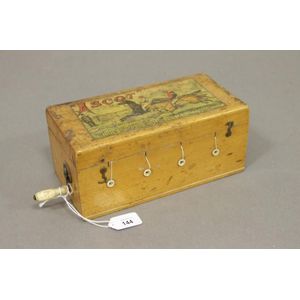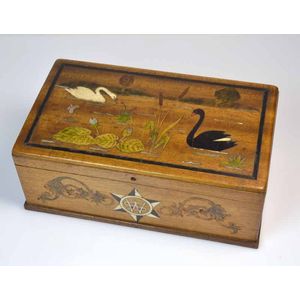Rare Australian Folk Art Tea Caddy Box, 1929
You must be a subscriber, and be logged in to view price and dealer details.
Subscribe Now to view actual auction price for this item
When you subscribe, you have the option of setting the currency in which to display prices to $Au, $US, $NZ or Stg.
- Ebony - Ebony is a close grained timber, black in colour. It has a fine texture which can be polished to a high gloss, making it suitable for venereering, inlay and stringing and its use as solid timber is resticted to small decorative items and ornamental decoration, such as chess pieces and musical instrument parts. The term "ebonised" means "faux ebony", timber that has been darkened during the polishing process to resemble ebony.
- Maple - Maple, native to North America, is a dense heavy timber from light to yellow-brown in colour. It has very little distincive graining unless it is one of the variants such as birds-eye maple or burr maple, so was not used extensively for furniture in 18th and 19th century, where cabinetmakers and designers preferred timbers with more distinctive features such as mahogany, walnut, rosewood and oak.
Birds-eye maple has a seres of small spots linked by undulating lines in the grain, is highly sough and is used as a decorative veneer. Burr maple has larger and irregular grain swirls than birds-eye maple. - Jarrah - A eucalypt, known by its aboriginal name jarrah, it grows only in the south-west of Western Australia. The timber is a dark red-brown in colour with similar grain and colouring to mahogany and was used extensively in house construction as well as for making furniture.
- Oak - Native to Europe and England, oak has been used for joinery, furniture and building since the beginning of the medieval civilisation. It is a pale yellow in colour when freshly cut and darkens with age to a mid brown colour.
Oak as a furniture timber was superceded by walnut in the 17th century, and in the 18th century by mahogany,
Semi-fossilised bog oak is black in colour, and is found in peat bogs where the trees have fallen and been preserved from decay by the bog. It is used for jewellery and small carved trinkets.
Pollard oak is taken from an oak that has been regularly pollarded, that is the upper branches have been removed at the top of the trunk, result that new branches would appear, and over time the top would become ball-like. . When harvested and sawn, the timber displays a continuous surface of knotty circles. The timber was scarce and expensive and was used in more expensive pieces of furniture in the Regency and Victorian periods.
This item has been included into following indexes:
-
tea caddies, material
- pollard oak 16
- specimen wood 5
Visually similar items

Regency rosewood tea caddy, with brass inlay, lion ring handles, 3 section interior and brass barrel canisters, 35 cm wide, 16.3 cm deep, 16.3 cm high

An Edwardian Ascot boxed horse racing game with four painted lead horses pulled by winding the handle. Bone and brass fittings by Jaques & Son, London. Length 18 cm

Camphorwood box. Traditional Chinese style heavily carved decoration

Vintage rosewood brass bound jewellery box, fully fitted and lined interior, with mirror and removable tray. Keyed drawer below, key available. Height 18 cm, width 31 cm, depth 23 cm
